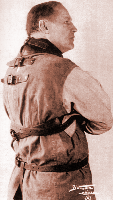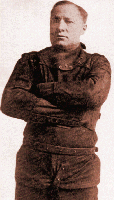At this time the strait-jacket escape was done inside a cabinet as were the escapes from handcuffs and manacles. Four years after Houdini's Wintergarten escape I was playing at the Beford Music Hall, Camdentown, London. I had difficulty with a committee after I had made my escape while inside the cabinet. The committee claimed, and were backed by a large part of the audience, that it was utterly impossible for me to have made my escape unaided and that I, somehow or other, had gotten an assistant in to unbuckle the straps. Therefore a few days later I accepted a challenge to escape on the stage and in full view of the audience. That night there was no stalling, I worked as hard and as fast as I knew how, and it took me just one hour. It was all on the level.
To escape from a regulation hospital jacket put on with the arms interlaced and the buckles and straps tight is possible only if the performer can dis-locate at least one shoulder. The shoulder to be dislocated is that of the arm with the hand on top--you see you can interlace your arms two ways. As Houdini could dislocate either shoulder it was possi-ble for him to escape under any situation. As I can only dislocate one shoulder it is essential that I do not let the committee get my arms in the wrong position.
Provided the magician has some say in the matter of the escape--and
he should-- there are several tricks to know in connection with an escape
from a regulation jacket. Just what do I mean by a regulation jacket?
I will describe one. The material used in the jacket is sixteen ounce
canvas and leather. The body of the jacket is made of canvas and
the collar, straps, and cuffs are made of leather. The collar which
is about six inches high is riveted to the canvas. It is made
of soft--at least comparatively--leather. The jacket is made to open
in the back; collar and all. The collar is fastened together by three
straps and buckles. Below the arms is a strap which goes completely
around the body--this is the chest strap. There are two more of these
straps which go around the body--one at the waist and one over the hips.
All these straps are double; that is one strap inside the canvas and one
strap outside and riveted together. The hip strap has at the front
a strap and has a loop at its free end through which the hip strap passes
at the back after the after the crotch strap is in position. The
sleeves are the same heavy canvas as the jacket and are reinforced by a
strap running from the shoulders along the outside of the arm to the cuff.
The cuffs are made of heavy leather and are closed at the ends so that
the hands are kept inside. To the cuffs are riveted straps one with a buckle--so
that the arms may be strapped around the body.

This is the way the magician should see that the jacket is put on provided
he uses a regulation jacket. There are other kinds, specially made
ones, or regulation jackets from which have been cut the straps which hamper
the release. When the jacket is first being put on comes the most
important step. The magician grabs hold of the inside of the sleeves before
his hands go all the way in. He then immediately puts his arms at
his side, though retaining a tight grip on the sleeves. This gives
a small amount of slack. The collar they fasten as they wish--there
is nothing to do about it any way and it makes no difference. When
it comes to the chest strap the performer should expand his chest to its
fullest extent. Here a again slack can be gotten and the amount depends
upon one's expansion. Houdini had a seven and a half inch expansion
while mine has varied from six and a half inches to only six inches.
The stomach and hip and crotch straps are of no worry and so he may let
them be fastened as the committee wishes.
All the time the straps are being pulled the performer should run with the pull. It is effective from the audience's viewpoint as there is more action and also effective because it makes it much more difficult really to get the straps tight.
When they get to your arms it is possible--like forcing a card--seemingly to have the committee fix your arms as they wish but actually they are as the performer wants. When the committee takes hold of his elbows to push his arms in position the left arm moves more "easily" and therefore that left hand immediately goes under the right arm pit. Please remember that the performer continues to retain that inside grip on the sleeves until the committee has finished its work. As soon as the left hand is under the performer's right arm pit it becomes easier to move his right arm. This right arm swings around and under the left arm so that the right hand goes under left arm pit. In this position it looks as if the arms were interlaced, or folded, rather than merely crossed. The only difference in appearance is that, were they folded, the right hand would be on top of the left arm rather than under it which is not apt to be noticed even when studying a photograph and the performer never stands still to be studied.
When the arm straps are pulled I used to call out:
"Tight as you can get it?"
"Tight as you want it?"
"Well it's as tight as I want it."
Here perhaps is as good a place as any note that it took many years
to get this effect down so that it was comparatively easy and at the same
time appealing to the audience. Above I noted that it took one hour-and
it was a grueling hour-the first time I did the escape in full view of
the audience. Later it was got down to a much shorter time.
My brother and 1, however, never went in for speed, but tried to get the
most showmanship into it instead.
This is the precise routine for the release after having been strapped
as described above.
First look it all over as if trying to discover just what the committee
has done. Then bend backwards and forwards and run a few steps from
side to side. Finally drop on one knee. This, so far, is all
showmanship. Then roll over on your back and wriggle-this may loosen
back buckles but does nothing else.
Then get up, run a few steps and make a complete forward somersault. (In the dislocation method this somersault bump was necessary.) As the somersault is made, you let go of the grip on the sleeves which gives enough slack to throw the arms over the head. The arms are now free but encased still in the sleeves. The straps of the sleeves are still buckled. Then get on both knees and open buckle with your teeth. If the strap is very stiff this may be a tough job. Sometimes it is easier to push a stiff strap open by pressing on the end with your teeth.
After the arms are separated, roll on back and bridging like a wrestler release hip strap and crotch strap. By this time you will be getting considerable slack. Then roll over on the knees and put your head to the floor as the Orientals salaam. In this position unbuckle the collar. It will be understood that in this unbuckling- the fingers have to work through the thick canvas, but that makes less difference than would be imagined.
Then roll on your back again and release the arm pit, or chest, strap.
At this point you are free except for the stomach strap and the fact that
your arms are still in the sleeves.
Stand up and lean forward and put one cuff under each foot. Then
exert every bit of strength and pull back. If the jacket comes off
somersault backwards -the jacket will fly up in the air in the opposite
direction. If that doesn't work there is nothing to do but to buckle
your arms together again and put the strap over your feet-lay on your back
and kick the jacket off.
To my knowledge this is the first time the true method of an escape
from a regulation jacket has ever been given. As long as I am telling
the story I may as well tell it all. For the suspended escape a special
jacket is used. This has one collar strap, one chest strap, and one
hip strap. It does not have a crotch strap and it does have
